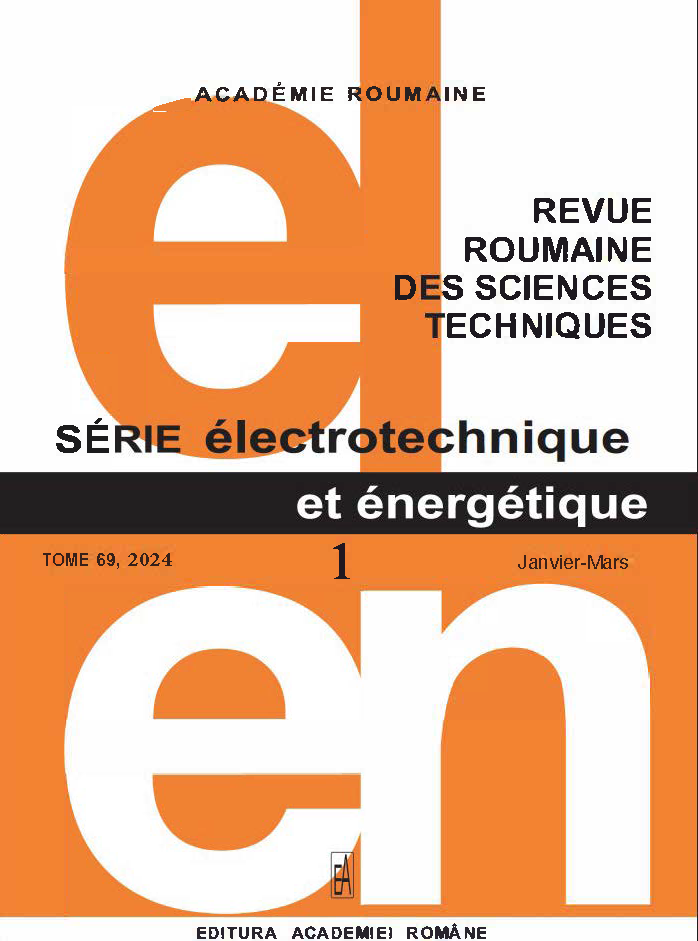THE DEPENDENCE BETWEEN THE OPTIMAL MECHANICAL ANGULAR SPEED AND THE VARIABLE WIND SPEED FROM AN ENERGETIC POINT OF VIEW
DOI:
https://doi.org/10.59277/RRST-EE.2024.1.9Keywords:
Optimal Mechanical Angular Speed, Maximum Power Point, Wind System, Power Control, Algorithm, Wind SpeedAbstract
This paper examines the fundamental elements required for operating a wind turbine (WT) at its maximum power point (MPP). It focuses on measuring the wind speed and the power output from the electric generator (EG) over time to establish the relationship between the optimal mechanical angular velocity (MAV) and the wind speed, denoted as the function ωOPTIM(V). This function is crucial for controlling the power output of the electric generator, ensuring that the WT operates at its maximum power point. The study analyzes the measurements taken from the turbines in Siliștea in Dobrogea, Romania. The paper concludes by presenting an algorithm to determine the function ωOPTIM(V).
References
(1) J. He, Y. Zhang, S. Yang, C. Li, Z. Hao, Optimal frequency control parameters design of wind farm considering wind turbine grouping, IEEE 6th Conference on Energy Internet and Energy System Integration (EI2), Chengdu, China, pp. 543–548 (2022).
(2) R. Karthik, A. Sri Hari, Y. V. Pavan Kumar, D. John Pradeep, Modelling and control design for variable speed wind turbine energy system, International Conference on Artificial Intelligence and Signal Processing (AISP) (2020).
(3) S. P. Singh, R. Kumar and P. Kumar, Analysis of wind resource on a site using wind turbine mathematical model on MATLAB/Simulink, 2023 5th International Conference on Energy, Power and Environment: Towards Flexible Green Energy Technologies (ICEPE), Shillong, India, pp. 1–6 (2023).
(4) H. Kulkarni, A. Kulkarni, T. Pagire, S. Magdum, mathematical modeling, installation of wind turbine and its analysis in MATLAB, International Conference on Electronics and Renewable Systems (ICEARS), Tuticorin, India, pp. 142–149 (2022).
(5) L. Wang, W. Wang, J. Gong, K. Liao, C. Hu, X. Li, generating capacity improvement method and analysis for the large horizontal axis wind turbine, 3rd International Conference on Advanced Electrical and Energy Systems (AEES), Lanzhou, China, pp. 47–51 (2022).
(6) S. Malekmohammadi, M. Amini, S. Esmaeili, A.A. Najafabadi, S.H. Fathi, impact of the high penetration PMSG-based wind turbine on power system transient stability, 12th Smart Grid Conference (SGC), Kerman, Islamic Republic of Iran, pp. 1–5 (2022).
(7) F. Shiravani, J.A. Cortajarena, P. Alkorta, M.G. Perez, O. Barambones, A predictive control based scheme for maximum power extraction of PMSG based wind turbine systems, IEEE 32nd International Symposium on Industrial Electronics (ISIE), Helsinki, Finland, pp. 1–6 (2023).
(8) Q. Chen et al., Bounded UDE-based MPPT control for wind turbines, 12th International Conference on Information Science and Technology (ICIST), Kaifeng, China, pp. 139–144 (2022).
(9) A.E. Oflaz, M. Yesilbudak, Comparison of outlier detection approaches for wind turbine power curves, 10th International Conference on Smart Grid (icSmartGrid), Istanbul, Turkey, pp. 363–367 (2022).
(10) N.A.N.B. Zainudin et al., Investigation of MPC performance for wind turbine system during wind speed uncertainty, IEEE International Conference on Power and Energy (PECon), Langkawi, Kedah, Malaysia, pp. 346–350 (2022).
(11) A. Routray, S.H. Hur, Predictive Control of Wind turbine using preview wind speed information, IEEE Energy Conversion Congress, and Exposition (ECCE), Detroit, MI, USA, pp. 1–7 (2022).
(12) R. Manikandan, Controlled dynamic analysis of offshore wind turbines under random environmental conditions – experimental investigations, International Conference on Power Electronics and Energy (ICPEE), Bhubaneswar, India, pp. 1–5 (2023).
(13) T.L. Thanh, D.V. Ngoc, E. Muljadi, V.P.T. Hai, M.N.L. Uyen, Wind turbine performance: consideration the execution of power performance verification, 13th International Conference on Power, Energy and Electrical Engineering (CPEEE), Tokyo, Japan, pp. 121–125 (2023).
(14) ***http://www.monsson.eu
(15) ***https://www.vestas.com
Downloads
Published
Issue
Section
License
Copyright (c) 2024 REVUE ROUMAINE DES SCIENCES TECHNIQUES — SÉRIE ÉLECTROTECHNIQUE ET ÉNERGÉTIQUE

This work is licensed under a Creative Commons Attribution-NonCommercial-NoDerivatives 4.0 International License.


